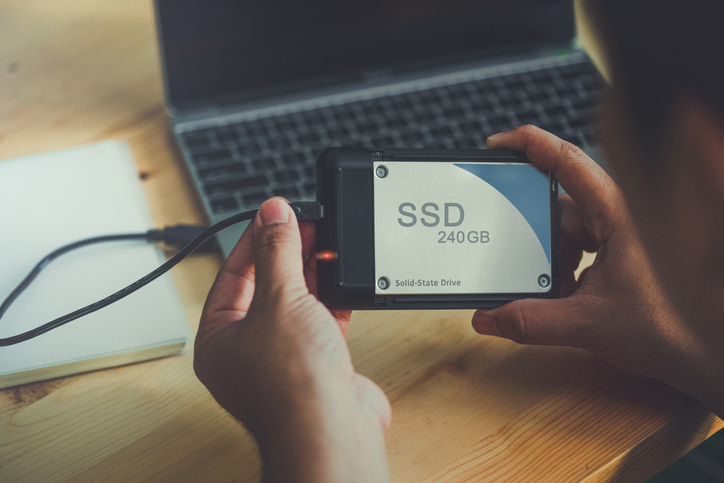Intelice Solutions: Blog

SSD or HDD Hard Drives: Which is Best for Your DC Metro Area Business?
SSD or HDD Hard Drives: Which is Best for Your DC Metro Area Business?
The question ‘which is better between SSD and HDD’ has no straightforward answer because it depends on what you intend to use it for.
Solid State Drives (SSDs) and Hard Disk Drives (HDDs) are two completely different technologies that serve the same purpose: data storage. Computer users have relied upon HDDs to store data for over half a century. Despite the introduction of newer SSDs in the previous decade, HDDs are still widely used for personal and business data storage.
If you are shopping for better storage for your business? Perhaps it is time to upgrade storage, or add more storage because you are running low? Whatever the case, you have come to the right place. Here is a technical summary of the difference between SSDs and HDDs to help you choose the right storage disks for your business.
What is an SSD?
SSD stands for Solid State Drive. This is a type of computer storage disk that uses interconnected flash memory chips to store information. As the name hints, Solid State Drives have no moving parts. Without spinning platters, arm or reading head, or motors, SSDs are much smaller in size and more shapely than the traditional HDDs.
SSDs are made to easily fit spaces designed for traditional HDDs and even SATA ports. This means that while they are a new technology, they are backward-compatible for use in most of today’s computers. Most modern laptops come with SSD drives mounted directly on the motherboard or the mini-PCI Express slot.
What is an HDD?
HDD, or Hard Disk Drive, is a storage disk that stores digital data on a magnetic tape. A hard disk has spinning disks made of metal platters coated with a magnetic material and an arm that moves a magnetic head to read and write data.
The rate at which a hard disk reads or writes data depends on the speed at which the metallic platters spin and the size of the disk. The most common sizes of hard disks are 2.5 inches for laptops and 3.5 inches for desktop machines. Hard disks predominantly come with disk rotation speeds of 5,400 or 7,200rpm. Top-of-the-range hard disks designed for enterprise use can clock in at 15,000rpm.
SSD or HDD: Storage Capacity
As of the end of 2021, consumer hard disk drives average a capacity of between 1 and 8 terabytes, with uncommon higher capacity drives reaching 20 terabytes.
Solid-state drives available on the market, on the other hand, come in capacities of between 50 and 100 terabytes.
Capacity is an important factor to consider when shopping for a computer storage disk. SSDs offer the greatest return on investment if your business needs as much storage as you can afford. If your business is planning on scaling, and data is at the center of your operations, then SSDs are a better investment.
SSD or HDD: Speed and Performance
SSD is a newer technology developed to overcome the limitations of the HDD, top on the list being speed and performance. Solid State Drives have data access times of under 0.1 microseconds. Hard Disk Drives are much slower with speeds of 5.5 to 8.0 microseconds. As they continue to evolve, SSDs are becoming faster, more stable, and reliable.
When it comes to data read and write speeds, the SSD wins over the HDD hands down. Hard disk drives have an input/output data request time of between 400 and 500 microseconds while Solid State Drives clock between 10 and 20 microseconds.
Performance-wise, SSDs are over 100 times faster than SSDs. Where HDDs average 400 read/write cycles per second, SSDs can read and write over 6000 times in a second. This means that programs loaded from the SSD run and save faster than those run from the HDD.
SSD or HDD: Power and Efficiency
SSDs are more power-efficient than hard disk drives for a good reason: They have no moving parts. The average HDD needs between 6 and 15 Watts of power whereas an SSD needs only between 2 and 5 Watts. When servers are equipped with HDDs, the average power consumption for the disks is 7%. When equipped with SSDs, the power consumption for the disks is a mere 1%.
SSDs do not heat up as much as HDDs do, hence requiring less power to cool them down. SSDs also use less power because they are in an idle state most of the time compared to HDDs that must continually spin to read and write data.
The performance of SSDs is significantly higher than that of HDDs. Today’s SSDs can read sequential data at speeds of up to 550MBps and write to disk at speeds of up to 520MBps. HDDs are capable of only 125MBps read/write speeds on sequential data.
SSD or HDD: Lifespan
The technology behind SSDs is evolving fast. Solid State Drives made a few years ago had significantly shorter lifespans – and limited write cycles. Today, however, SSDs are built to last up to 10 years. The lifespan of hard disks has leveled out at between 5 and 10 years.
SSDs last longer than HDDs because they have no moving parts, do not heat up, and are less susceptible to damage due to shock and magnetic interference. Today’s SSDs also offer improved data integrity and endurance. The failure rate for HDDs is approximately 2-5% per year while that of SSDs is 0.5%.
One downside that SSDs have is limited read and write cycles. This means that eventually, a solid-state drive will need to be replaced regardless of how well it is cared for. The estimated maximum write cycle of an SSD disk today is 3000 before the disk cells begin to break down.
SSD or HDD: Drive Cost
Despite magnetic storage being old technology, there still exists a significant market share for traditional hard disks. The prices of SSDs continue to fall and consequently, the prices of HDDs. On average, SSDs cost $0.07 per gigabyte today while HDDs cost less than half at $0.03 per gigabyte. The price difference per gigabyte is much narrower for higher-capacity drives.
Conclusion: To Buy SSD or HDD?
Whether you need a storage drive for your office desktop computer, laptop, or server, there are benefits of going for either SSD or HDD. However, your preferred setup will influence performance significantly. Businesses today are taking advantage of the higher capacity and performance of SSDs and the lower price of HDD to equip their machines with both SSDs and HDDs. If your computer supports multiple disks, this is the most viable setup.
Considering the high costs of reliable computer storage, no business can afford to make the wrong investment. Visit the Intelice blog to learn more about computer storage and associated technologies and get professional help shopping for the right hardware or software for your business.




